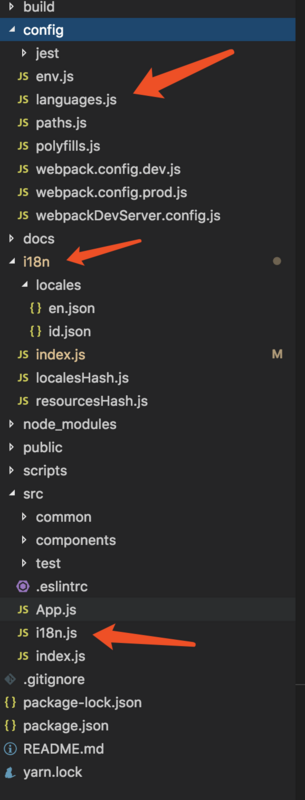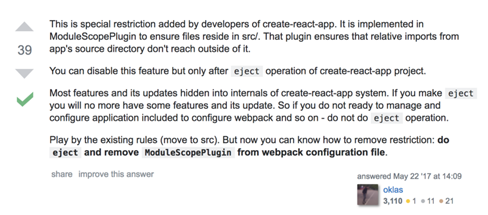您好,登錄后才能下訂單哦!
您好,登錄后才能下訂單哦!
這篇文章給大家介紹怎么在react中實現國際化,內容非常詳細,感興趣的小伙伴們可以參考借鑒,希望對大家能有所幫助。
先睹為快
先看一下最后的成果:
// ...
import i18n from '@src/i18n';
// xxx component
console.log('哈哈哈哈哈i18n來一發:', i18n.t('INVALID_ORDER'));
// ...
render() {
// ...
<button> {i18n.t('INVALID_ORDER')} <button>
}控制臺中:

對應json 中的信息:

開始
原理
原理其實很簡單: 字符串替換。
拉取遠程的國際化json文件到本地,再根據語言做一個映射就可以了。
廢話不多說, 來看代碼吧。
先簡單看一下目錄結構:

先看一下 config 里面的 相關代碼:
env.js:
'use strict';
const fs = require('fs');
const path = require('path');
const paths = require('./paths');
const languages = require('./languages');
// Make sure that including paths.js after env.js will read .env variables.
delete require.cache[require.resolve('./paths')];
const NODE_ENV = process.env.NODE_ENV;
if (!NODE_ENV) {
throw new Error(
'The NODE_ENV environment variable is required but was not specified.'
);
}
// https://github.com/bkeepers/dotenv#what-other-env-files-can-i-use
var dotenvFiles = [
`${paths.dotenv}.${NODE_ENV}.local`,
`${paths.dotenv}.${NODE_ENV}`,
// Don't include `.env.local` for `test` environment
// since normally you expect tests to produce the same
// results for everyone
NODE_ENV !== 'test' && `${paths.dotenv}.local`,
paths.dotenv,
].filter(Boolean);
// Load environment variables from .env* files. Suppress warnings using silent
// if this file is missing. dotenv will never modify any environment variables
// that have already been set. Variable expansion is supported in .env files.
// https://github.com/motdotla/dotenv
// https://github.com/motdotla/dotenv-expand
dotenvFiles.forEach(dotenvFile => {
if (fs.existsSync(dotenvFile)) {
require('dotenv-expand')(
require('dotenv').config({
path: dotenvFile,
})
);
}
});
// We support resolving modules according to `NODE_PATH`.
// This lets you use absolute paths in imports inside large monorepos:
// https://github.com/facebookincubator/create-react-app/issues/253.
// It works similar to `NODE_PATH` in Node itself:
// https://nodejs.org/api/modules.html#modules_loading_from_the_global_folders
// Note that unlike in Node, only *relative* paths from `NODE_PATH` are honored.
// Otherwise, we risk importing Node.js core modules into an app instead of Webpack shims.
// https://github.com/facebookincubator/create-react-app/issues/1023#issuecomment-265344421
// We also resolve them to make sure all tools using them work consistently.
const appDirectory = fs.realpathSync(process.cwd());
process.env.NODE_PATH = (process.env.NODE_PATH || '')
.split(path.delimiter)
.filter(folder => folder && !path.isAbsolute(folder))
.map(folder => path.resolve(appDirectory, folder))
.join(path.delimiter);
// Grab NODE_ENV and REACT_APP_* environment variables and prepare them to be
// injected into the application via DefinePlugin in Webpack configuration.
const REACT_APP = /^REACT_APP_/i;
function getClientEnvironment(publicUrl) {
const raw = Object.keys(process.env)
.filter(key => REACT_APP.test(key))
.reduce(
(env, key) => {
env[key] = process.env[key];
return env;
},
{
// Useful for determining whether we're running in production mode.
// Most importantly, it switches React into the correct mode.
NODE_ENV: process.env.NODE_ENV || 'development',
// Useful for resolving the correct path to static assets in `public`.
// For example, <img src={process.env.PUBLIC_URL + '/img/logo.png'} />.
// This should only be used as an escape hatch. Normally you would put
// images into the `src` and `import` them in code to get their paths.
PUBLIC_URL: publicUrl,
LANGUAGE: {
resources: languages.resources,
defaultLng: languages.defaultLng
},
COUNTRY: process.env.COUNTRY
}
);
// Stringify all values so we can feed into Webpack DefinePlugin
const stringified = {
'process.env': Object.keys(raw).reduce((env, key) => {
env[key] = JSON.stringify(raw[key]);
return env;
}, {}),
};
return { raw, stringified };
}
module.exports = getClientEnvironment;主要看lannguage 相關的代碼就好了, 其他的都create-react-app 的相關配置, 不用管。
再看下 language.js 里面的邏輯:
const path = require('path');
const paths = require('./paths');
const localesHash = require('../i18n/localesHash');
const resourcesHash = require('../i18n/resourcesHash');
const COUNTRY = process.env.COUNTRY || 'sg';
const country = (COUNTRY).toUpperCase();
const defaultLng = localesHash[country][0];
const langs = [
'en',
'id'
];
const prefixLangs = [];
const entries = {};
for (let i = 0, len = langs.length; i < len; i++) {
const prefixLang = `dict_${langs[i]}`
prefixLangs.push(prefixLang)
entries[prefixLang] = path.resolve(paths.appSrc, `../i18n/locales/${langs[i]}.json`)
}
const resources = {
[defaultLng]: {
common: resourcesHash[defaultLng]
}
}
exports.resources = resources;
exports.defaultLng = defaultLng;邏輯也比較簡單, 根據語言列表把對應的json 內容加進來。 作為示例,這里我設置的是 英文 和 印尼語。
下面看 i18n 文件里面的內容:
locales 里面放的是語言的json 文件, 內容大概是:
{
"msg_Created": "Pesanan telah terbuat"
// ...
}localesHash.js:
module.exports = {
SG: ['en'],
ID: ['id']
}resourcesHash.js:
module.exports = {
'en': require('./locales/en.json'),
'id': require('./locales/id.json')
}index.js
const path = require('path')
const fs = require('fs')
const fetch = require('isomorphic-fetch')
const localesHash = require('./localesHash')
const argv = process.argv.slice(2)
const country = (argv[0] || '').toUpperCase()
const i18nServerURI = locale => {
const keywords = {
'en': 'en',
'id': 'id'
}
const keyword = keywords[locale]
return keyword === 'en'
? 'xxx/json/download'
: `/${keyword}/json/download`
}
const fetchKeys = async (locale) => {
const uri = i18nServerURI(locale)
console.log(`Downloading ${locale} keys...\n${uri}`)
const respones = await fetch(uri)
const keys = await respones.json()
return keys
}
const access = async (filepath) => {
return new Promise((resolve, reject) => {
fs.access(filepath, (err) => {
if (err) {
if (err.code === 'EXIST') {
resolve(true)
}
resolve(false)
}
resolve(true)
})
})
}
const run = async () => {
const locales = localesHash[country] || Object
.values(localesHash)
.reduce(
(previous, current) =>
previous.concat(current), []
)
if (locales === undefined) {
console.error('This country is not in service.')
return
}
for (const locale of locales) {
const keys = await fetchKeys(locale)
const data = JSON.stringify(keys, null, 2)
const directoryPath = path.resolve(__dirname, 'locales')
if (!fs.existsSync(directoryPath)) {
fs.mkdirSync(directoryPath)
}
const filepath = path.resolve(__dirname, `locales/${locale}.json`)
const isExist = await access(filepath)
const operation = isExist ? 'update' : 'create'
console.log(operation)
fs.writeFileSync(filepath, `${data}\n`)
console.log(`${operation}\t${filepath}`)
}
}
run();再看下src 中的配置:
i18nn.js
import i18next from 'i18next'
import { firstLetterUpper } from './common/helpers/util';
const env = process.env;
let LANGUAGE = process.env.LANGUAGE;
LANGUAGE = typeof LANGUAGE === 'string' ? JSON.parse(LANGUAGE) : LANGUAGE
const { defaultLng, resources } = LANGUAGE
i18next
.init({
lng: defaultLng,
fallbackLng: defaultLng,
defaultNS: 'common',
keySeparator: false,
debug: env.NODE_ENV === 'development',
resources,
interpolation: {
escapeValue: false
},
react: {
wait: false,
bindI18n: 'languageChanged loaded',
bindStore: 'added removed',
nsMode: 'default'
}
})
function isMatch(str, substr) {
return str.indexOf(substr) > -1 || str.toLowerCase().indexOf(substr) > -1
}
export const changeLanguage = (locale) => {
i18next.changeLanguage(locale)
}
// Uppercase the first letter of every word. abcd => Abcd or abcd efg => Abcd Efg
export const tUpper = (str, allWords = true) => {
return firstLetterUpper(i18next.t(str), allWords)
}
// Uppercase all letters. abcd => ABCD
export const tUpperCase = (str) => {
return i18next.t(str).toUpperCase()
}
export const loadResource = lng => {
let p;
return new Promise((resolve, reject) => {
if (isMatch(defaultLng, lng)) resolve()
switch (lng) {
case 'id':
p = import('../i18n/locales/id.json')
break
default:
p = import('../i18n/locales/en.json')
}
p.then(data => {
i18next.addResourceBundle(lng, 'common', data)
changeLanguage(lng)
})
.then(resolve)
.catch(reject)
})
}
export default i18next // firstLetterUpper
export const firstLetterUpper = (str, allWords = true) => {
let tmp = str.replace(/^(.)/g, $1 => $1.toUpperCase())
if (allWords) {
tmp = tmp.replace(/\s(.)/g, $1 => $1.toUpperCase())
}
return tmp;
}這些準備工作做好后, 還需要把i18n 注入到app中:
index.js:
import React from 'react';
import { render } from 'react-dom';
import { Provider } from 'react-redux';
import rootReducer from './common/redux/reducers';
import { configureStore } from './common/redux/store';
import { Router } from 'react-router-dom';
import createBrowserHistory from 'history/createBrowserHistory';
import { I18nextProvider } from 'react-i18next';
import i18n from './i18n';
import './common/styles/index.less';
import App from './App';
export const history = createBrowserHistory();
const ROOT = document.getElementById('root');
render(
<I18nextProvider i18n={i18n}>
<Provider store={configureStore(rootReducer)} >
<Router history={history}>
<App />
</Router>
</Provider>
</I18nextProvider>,
ROOT
);如何使用
加入上面的代碼后, 控制臺會有一些log 信息, 表示語言已經加載好了。

在具體的業務組件中,使用方法是:
// ...
import i18n from '@src/i18n';
console.log('哈哈哈哈哈i18n來一發:', i18n.t('INVALID_ORDER'));控制臺中:

對應json 中的信息:

后面你就可以愉快的加各種詞條了。
Tips
我們在src 中的文件中引入了src 目錄外的文件, 這是create-react-app 做的限制, 編譯會報錯, 把它去掉就好了:


結語
這里作為例, 就是把語言的json 文件下載下來放到locales 目錄里, 如果想實時拉取,要保證文件下載完之后再render app.
類似:
loadResource(getLocale())
.then(() => {
import('./app.js')
})關于怎么在react中實現國際化就分享到這里了,希望以上內容可以對大家有一定的幫助,可以學到更多知識。如果覺得文章不錯,可以把它分享出去讓更多的人看到。
免責聲明:本站發布的內容(圖片、視頻和文字)以原創、轉載和分享為主,文章觀點不代表本網站立場,如果涉及侵權請聯系站長郵箱:is@yisu.com進行舉報,并提供相關證據,一經查實,將立刻刪除涉嫌侵權內容。